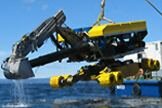visits
776
votes
20
votes++Vote positively this post :)
+32
votes--Vote negatively this post :(
-12
The impressive submarine cables (first part)


The transoceanic cables are being installed in the sea since 1858. As curious fact, a little before of this date, thanks to the investigations made about the future localization of the telegraph cable, the oceanic ridge was discovered, although in a principle was though that the ridge was a plateau. Those first cables were of cooper and had a cover of waterproof material called gutta-percha.
A century later, in 1960, began the use of coaxial cables shielded in the telephonically communications.
At last, in 1980, comes the optical fiber, that isn't sensible to the electromagnetic interferences and, also, can arrive more far using less repeaters than with the coaxial cables. The electromagnetic interferences in the submarine coaxial cables are produced because, when the electrical current pass through, in the medium where it is (earth or water), an electric current in the opposite direction is generated, that can induce noise.
At present, the optical fiber cables are built with 8 types of cover to protect it. Inside of every cable, there are a lot of channels of communication that are mixed using different kinds of techniques of multiplexing, that consist in differentiate the channels in some way in order to that can travel by the same cable.
These cables transports the 99% of communications of the world, because is the transmission medium more cheap. The left 1% are transmitted via satellite. More of the 70% of the wiring is dedicated to Internet; the rest belongs, principally, to private networks of big companies and, in a little percentage (around the 1%) to the telephone.
The cables aren't indestructible. Can be broken by avalanches, tsunamis, currents, movement of the continental plates, shark bites, certain fishing activities, anchors and even pirates that steal it to sell it. When something of that occurs can affect to million of users, although thanks to the Internet design don't usually they end totally isolated.
To solve these problems there are 24 boats in the world that take care of repair the cables. A total 50 reparations are made in a year.
To bury and maintain the cables, these boats have with cranes and vehicles like the following:

These are vehicles controlled remotely and are equipped with all kind of instruments. This specifically, is suited for work down to a maximum 2500m and have burial tool system, manipulators, sonar system, echo sounder (altimeter), cable tracker, acoustic positioning and surveillance cameras.
In the next post, I will explain how work the repeaters and how is posible the installation of this cables on the oceanic ridges.